Business Report: Tesco, NHS, Oxfam - Organizational Analysis
VerifiedAdded on 2023/01/13
|12
|3156
|62
Report
AI Summary
This business report provides a comprehensive analysis of three distinct business organizations: Tesco, NHS, and Oxfam. The report begins with an introduction to the business environment and categorizes the organizations as private (Tesco), public (NHS), and voluntary (Oxfam). It explores the purpose, size, and scope of each organization, followed by an examination of the interrelationships between organizational functions, particularly focusing on Tesco's sales, marketing, and HR departments. The report also includes PESTLE and SWOT analyses for Tesco, evaluating the influence of political, economic, social, technological, legal, and environmental factors, as well as internal strengths, weaknesses, opportunities, and threats. The report concludes by summarizing the key findings and implications for organizational strategy and decision-making, highlighting the impact of globalization on business operations.
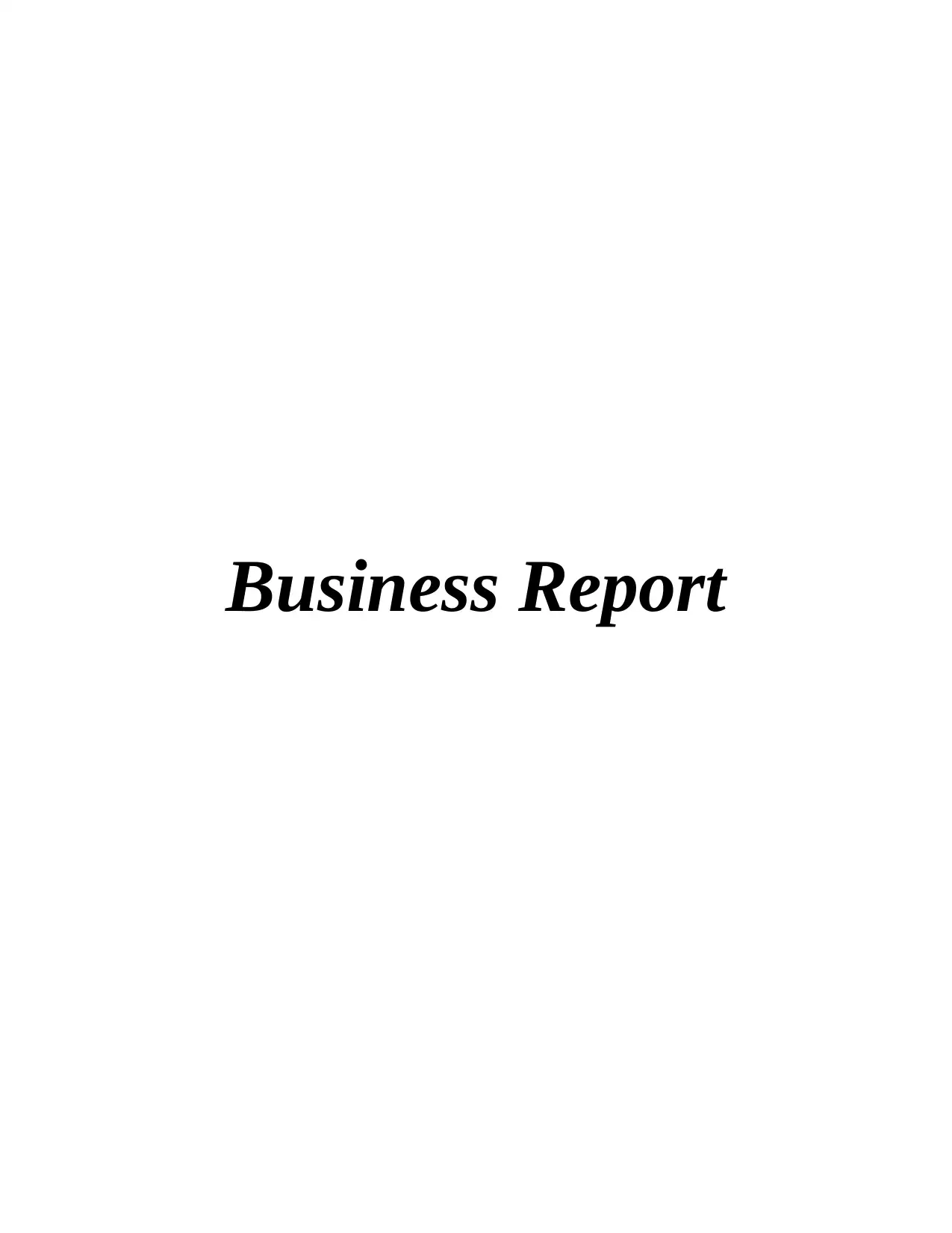
Business Report
Paraphrase This Document
Need a fresh take? Get an instant paraphrase of this document with our AI Paraphraser

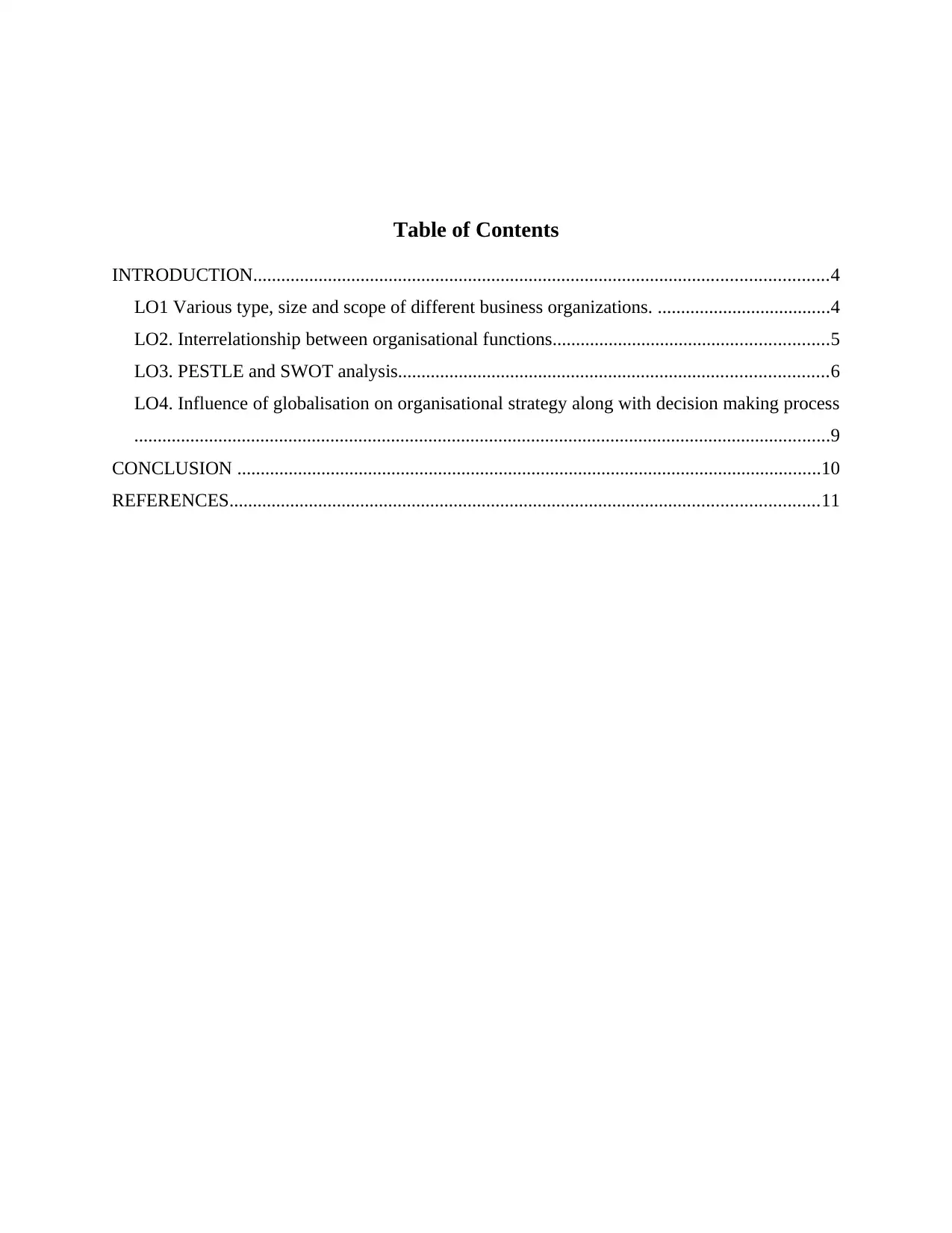
Table of Contents
INTRODUCTION...........................................................................................................................4
LO1 Various type, size and scope of different business organizations. .....................................4
LO2. Interrelationship between organisational functions...........................................................5
LO3. PESTLE and SWOT analysis............................................................................................6
LO4. Influence of globalisation on organisational strategy along with decision making process
.....................................................................................................................................................9
CONCLUSION .............................................................................................................................10
REFERENCES..............................................................................................................................11
INTRODUCTION...........................................................................................................................4
LO1 Various type, size and scope of different business organizations. .....................................4
LO2. Interrelationship between organisational functions...........................................................5
LO3. PESTLE and SWOT analysis............................................................................................6
LO4. Influence of globalisation on organisational strategy along with decision making process
.....................................................................................................................................................9
CONCLUSION .............................................................................................................................10
REFERENCES..............................................................................................................................11
⊘ This is a preview!⊘
Do you want full access?
Subscribe today to unlock all pages.

Trusted by 1+ million students worldwide
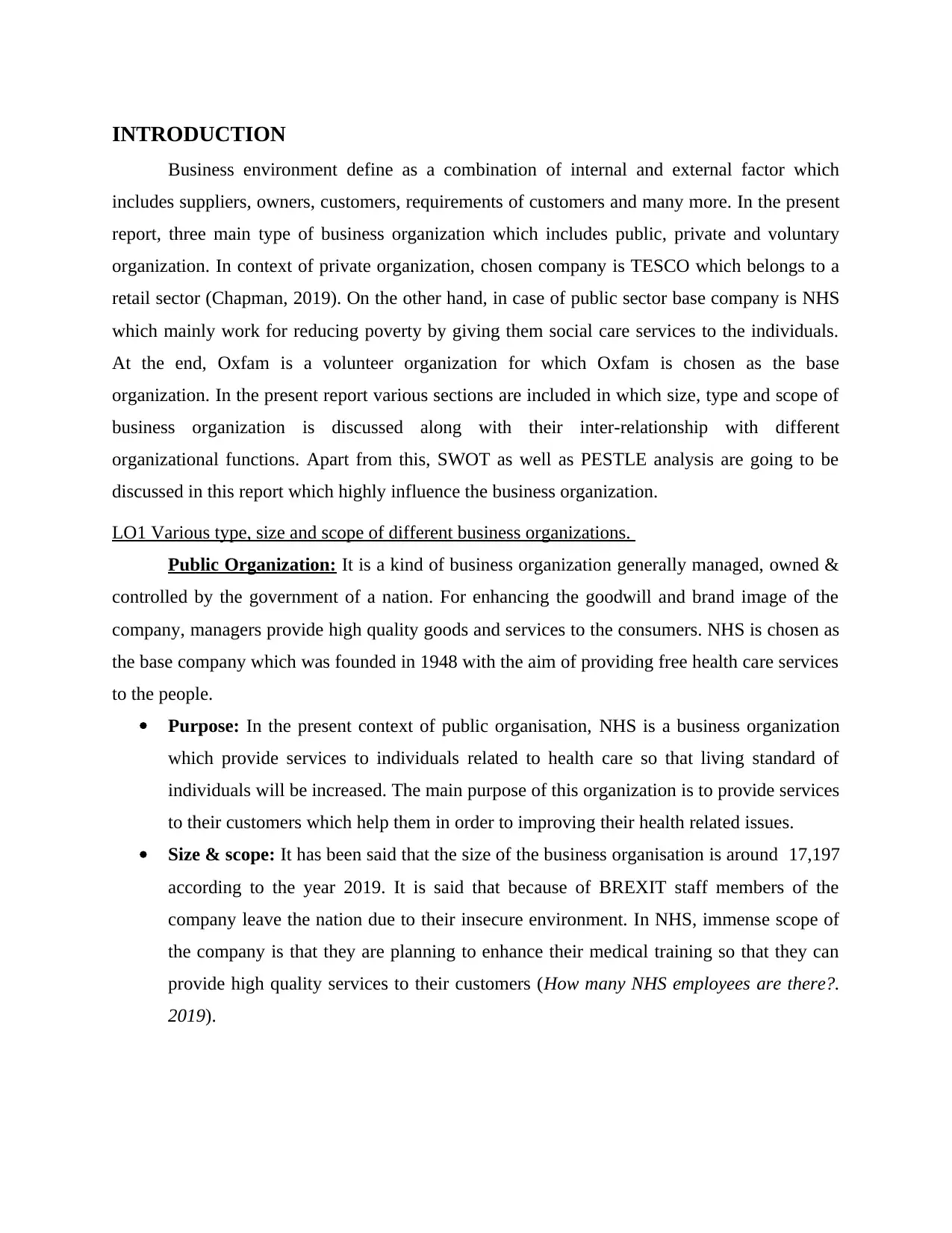
INTRODUCTION
Business environment define as a combination of internal and external factor which
includes suppliers, owners, customers, requirements of customers and many more. In the present
report, three main type of business organization which includes public, private and voluntary
organization. In context of private organization, chosen company is TESCO which belongs to a
retail sector (Chapman, 2019). On the other hand, in case of public sector base company is NHS
which mainly work for reducing poverty by giving them social care services to the individuals.
At the end, Oxfam is a volunteer organization for which Oxfam is chosen as the base
organization. In the present report various sections are included in which size, type and scope of
business organization is discussed along with their inter-relationship with different
organizational functions. Apart from this, SWOT as well as PESTLE analysis are going to be
discussed in this report which highly influence the business organization.
LO1 Various type, size and scope of different business organizations.
Public Organization: It is a kind of business organization generally managed, owned &
controlled by the government of a nation. For enhancing the goodwill and brand image of the
company, managers provide high quality goods and services to the consumers. NHS is chosen as
the base company which was founded in 1948 with the aim of providing free health care services
to the people.
Purpose: In the present context of public organisation, NHS is a business organization
which provide services to individuals related to health care so that living standard of
individuals will be increased. The main purpose of this organization is to provide services
to their customers which help them in order to improving their health related issues.
Size & scope: It has been said that the size of the business organisation is around 17,197
according to the year 2019. It is said that because of BREXIT staff members of the
company leave the nation due to their insecure environment. In NHS, immense scope of
the company is that they are planning to enhance their medical training so that they can
provide high quality services to their customers (How many NHS employees are there?.
2019).
Business environment define as a combination of internal and external factor which
includes suppliers, owners, customers, requirements of customers and many more. In the present
report, three main type of business organization which includes public, private and voluntary
organization. In context of private organization, chosen company is TESCO which belongs to a
retail sector (Chapman, 2019). On the other hand, in case of public sector base company is NHS
which mainly work for reducing poverty by giving them social care services to the individuals.
At the end, Oxfam is a volunteer organization for which Oxfam is chosen as the base
organization. In the present report various sections are included in which size, type and scope of
business organization is discussed along with their inter-relationship with different
organizational functions. Apart from this, SWOT as well as PESTLE analysis are going to be
discussed in this report which highly influence the business organization.
LO1 Various type, size and scope of different business organizations.
Public Organization: It is a kind of business organization generally managed, owned &
controlled by the government of a nation. For enhancing the goodwill and brand image of the
company, managers provide high quality goods and services to the consumers. NHS is chosen as
the base company which was founded in 1948 with the aim of providing free health care services
to the people.
Purpose: In the present context of public organisation, NHS is a business organization
which provide services to individuals related to health care so that living standard of
individuals will be increased. The main purpose of this organization is to provide services
to their customers which help them in order to improving their health related issues.
Size & scope: It has been said that the size of the business organisation is around 17,197
according to the year 2019. It is said that because of BREXIT staff members of the
company leave the nation due to their insecure environment. In NHS, immense scope of
the company is that they are planning to enhance their medical training so that they can
provide high quality services to their customers (How many NHS employees are there?.
2019).
Paraphrase This Document
Need a fresh take? Get an instant paraphrase of this document with our AI Paraphraser
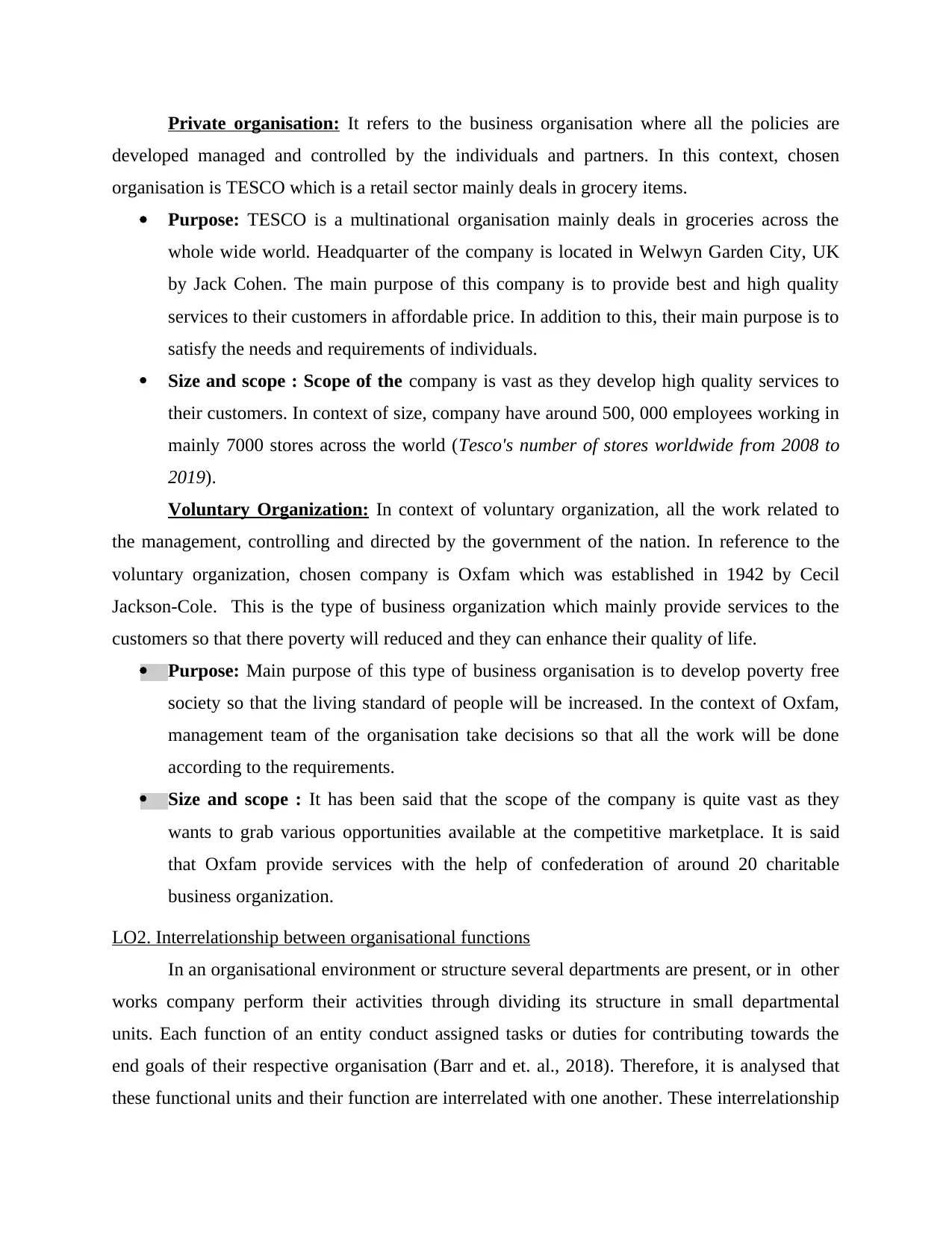
Private organisation: It refers to the business organisation where all the policies are
developed managed and controlled by the individuals and partners. In this context, chosen
organisation is TESCO which is a retail sector mainly deals in grocery items.
Purpose: TESCO is a multinational organisation mainly deals in groceries across the
whole wide world. Headquarter of the company is located in Welwyn Garden City, UK
by Jack Cohen. The main purpose of this company is to provide best and high quality
services to their customers in affordable price. In addition to this, their main purpose is to
satisfy the needs and requirements of individuals.
Size and scope : Scope of the company is vast as they develop high quality services to
their customers. In context of size, company have around 500, 000 employees working in
mainly 7000 stores across the world (Tesco's number of stores worldwide from 2008 to
2019).
Voluntary Organization: In context of voluntary organization, all the work related to
the management, controlling and directed by the government of the nation. In reference to the
voluntary organization, chosen company is Oxfam which was established in 1942 by Cecil
Jackson-Cole. This is the type of business organization which mainly provide services to the
customers so that there poverty will reduced and they can enhance their quality of life.
Purpose: Main purpose of this type of business organisation is to develop poverty free
society so that the living standard of people will be increased. In the context of Oxfam,
management team of the organisation take decisions so that all the work will be done
according to the requirements.
Size and scope : It has been said that the scope of the company is quite vast as they
wants to grab various opportunities available at the competitive marketplace. It is said
that Oxfam provide services with the help of confederation of around 20 charitable
business organization.
LO2. Interrelationship between organisational functions
In an organisational environment or structure several departments are present, or in other
works company perform their activities through dividing its structure in small departmental
units. Each function of an entity conduct assigned tasks or duties for contributing towards the
end goals of their respective organisation (Barr and et. al., 2018). Therefore, it is analysed that
these functional units and their function are interrelated with one another. These interrelationship
developed managed and controlled by the individuals and partners. In this context, chosen
organisation is TESCO which is a retail sector mainly deals in grocery items.
Purpose: TESCO is a multinational organisation mainly deals in groceries across the
whole wide world. Headquarter of the company is located in Welwyn Garden City, UK
by Jack Cohen. The main purpose of this company is to provide best and high quality
services to their customers in affordable price. In addition to this, their main purpose is to
satisfy the needs and requirements of individuals.
Size and scope : Scope of the company is vast as they develop high quality services to
their customers. In context of size, company have around 500, 000 employees working in
mainly 7000 stores across the world (Tesco's number of stores worldwide from 2008 to
2019).
Voluntary Organization: In context of voluntary organization, all the work related to
the management, controlling and directed by the government of the nation. In reference to the
voluntary organization, chosen company is Oxfam which was established in 1942 by Cecil
Jackson-Cole. This is the type of business organization which mainly provide services to the
customers so that there poverty will reduced and they can enhance their quality of life.
Purpose: Main purpose of this type of business organisation is to develop poverty free
society so that the living standard of people will be increased. In the context of Oxfam,
management team of the organisation take decisions so that all the work will be done
according to the requirements.
Size and scope : It has been said that the scope of the company is quite vast as they
wants to grab various opportunities available at the competitive marketplace. It is said
that Oxfam provide services with the help of confederation of around 20 charitable
business organization.
LO2. Interrelationship between organisational functions
In an organisational environment or structure several departments are present, or in other
works company perform their activities through dividing its structure in small departmental
units. Each function of an entity conduct assigned tasks or duties for contributing towards the
end goals of their respective organisation (Barr and et. al., 2018). Therefore, it is analysed that
these functional units and their function are interrelated with one another. These interrelationship
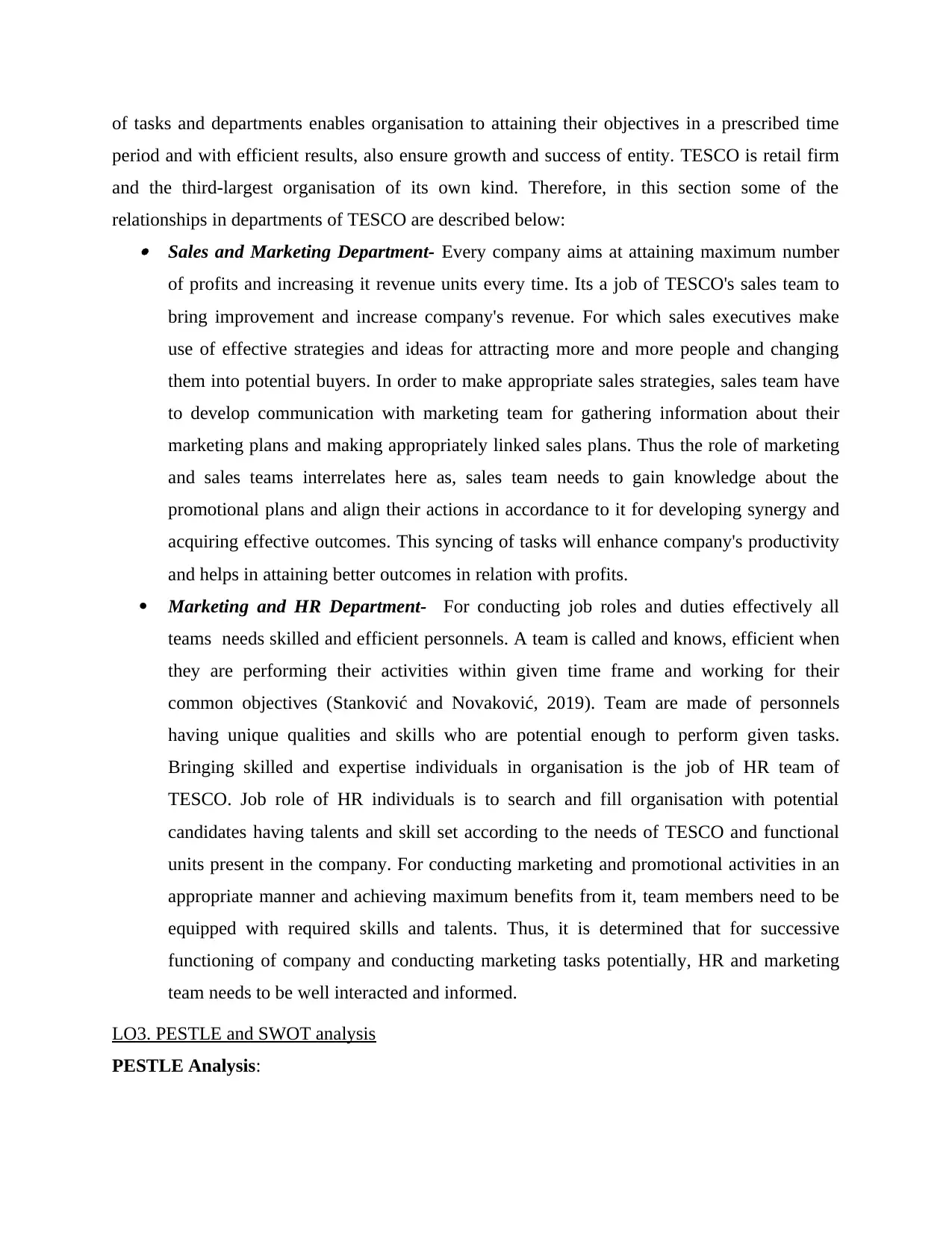
of tasks and departments enables organisation to attaining their objectives in a prescribed time
period and with efficient results, also ensure growth and success of entity. TESCO is retail firm
and the third-largest organisation of its own kind. Therefore, in this section some of the
relationships in departments of TESCO are described below: Sales and Marketing Department- Every company aims at attaining maximum number
of profits and increasing it revenue units every time. Its a job of TESCO's sales team to
bring improvement and increase company's revenue. For which sales executives make
use of effective strategies and ideas for attracting more and more people and changing
them into potential buyers. In order to make appropriate sales strategies, sales team have
to develop communication with marketing team for gathering information about their
marketing plans and making appropriately linked sales plans. Thus the role of marketing
and sales teams interrelates here as, sales team needs to gain knowledge about the
promotional plans and align their actions in accordance to it for developing synergy and
acquiring effective outcomes. This syncing of tasks will enhance company's productivity
and helps in attaining better outcomes in relation with profits.
Marketing and HR Department- For conducting job roles and duties effectively all
teams needs skilled and efficient personnels. A team is called and knows, efficient when
they are performing their activities within given time frame and working for their
common objectives (Stanković and Novaković, 2019). Team are made of personnels
having unique qualities and skills who are potential enough to perform given tasks.
Bringing skilled and expertise individuals in organisation is the job of HR team of
TESCO. Job role of HR individuals is to search and fill organisation with potential
candidates having talents and skill set according to the needs of TESCO and functional
units present in the company. For conducting marketing and promotional activities in an
appropriate manner and achieving maximum benefits from it, team members need to be
equipped with required skills and talents. Thus, it is determined that for successive
functioning of company and conducting marketing tasks potentially, HR and marketing
team needs to be well interacted and informed.
LO3. PESTLE and SWOT analysis
PESTLE Analysis:
period and with efficient results, also ensure growth and success of entity. TESCO is retail firm
and the third-largest organisation of its own kind. Therefore, in this section some of the
relationships in departments of TESCO are described below: Sales and Marketing Department- Every company aims at attaining maximum number
of profits and increasing it revenue units every time. Its a job of TESCO's sales team to
bring improvement and increase company's revenue. For which sales executives make
use of effective strategies and ideas for attracting more and more people and changing
them into potential buyers. In order to make appropriate sales strategies, sales team have
to develop communication with marketing team for gathering information about their
marketing plans and making appropriately linked sales plans. Thus the role of marketing
and sales teams interrelates here as, sales team needs to gain knowledge about the
promotional plans and align their actions in accordance to it for developing synergy and
acquiring effective outcomes. This syncing of tasks will enhance company's productivity
and helps in attaining better outcomes in relation with profits.
Marketing and HR Department- For conducting job roles and duties effectively all
teams needs skilled and efficient personnels. A team is called and knows, efficient when
they are performing their activities within given time frame and working for their
common objectives (Stanković and Novaković, 2019). Team are made of personnels
having unique qualities and skills who are potential enough to perform given tasks.
Bringing skilled and expertise individuals in organisation is the job of HR team of
TESCO. Job role of HR individuals is to search and fill organisation with potential
candidates having talents and skill set according to the needs of TESCO and functional
units present in the company. For conducting marketing and promotional activities in an
appropriate manner and achieving maximum benefits from it, team members need to be
equipped with required skills and talents. Thus, it is determined that for successive
functioning of company and conducting marketing tasks potentially, HR and marketing
team needs to be well interacted and informed.
LO3. PESTLE and SWOT analysis
PESTLE Analysis:
⊘ This is a preview!⊘
Do you want full access?
Subscribe today to unlock all pages.

Trusted by 1+ million students worldwide
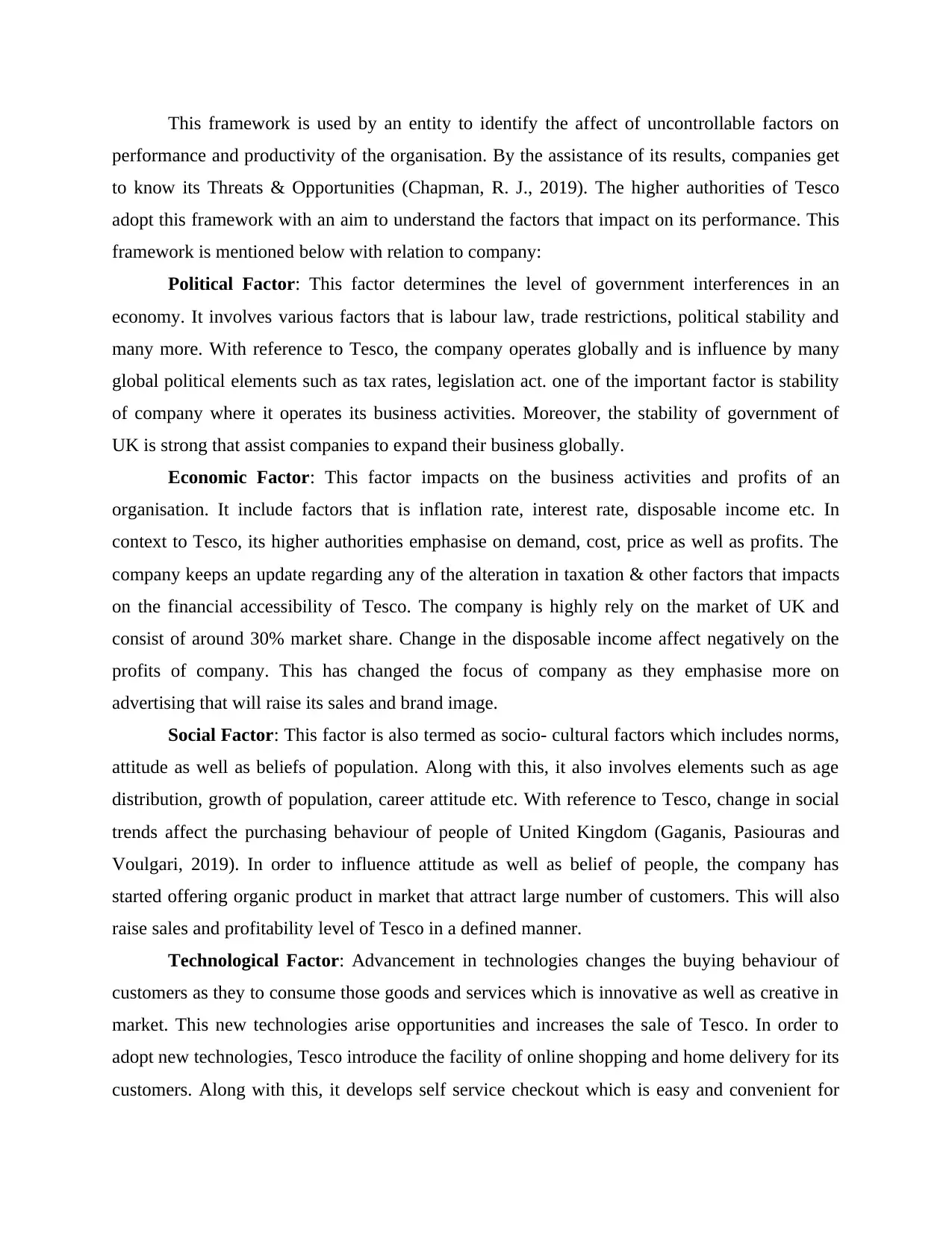
This framework is used by an entity to identify the affect of uncontrollable factors on
performance and productivity of the organisation. By the assistance of its results, companies get
to know its Threats & Opportunities (Chapman, R. J., 2019). The higher authorities of Tesco
adopt this framework with an aim to understand the factors that impact on its performance. This
framework is mentioned below with relation to company:
Political Factor: This factor determines the level of government interferences in an
economy. It involves various factors that is labour law, trade restrictions, political stability and
many more. With reference to Tesco, the company operates globally and is influence by many
global political elements such as tax rates, legislation act. one of the important factor is stability
of company where it operates its business activities. Moreover, the stability of government of
UK is strong that assist companies to expand their business globally.
Economic Factor: This factor impacts on the business activities and profits of an
organisation. It include factors that is inflation rate, interest rate, disposable income etc. In
context to Tesco, its higher authorities emphasise on demand, cost, price as well as profits. The
company keeps an update regarding any of the alteration in taxation & other factors that impacts
on the financial accessibility of Tesco. The company is highly rely on the market of UK and
consist of around 30% market share. Change in the disposable income affect negatively on the
profits of company. This has changed the focus of company as they emphasise more on
advertising that will raise its sales and brand image.
Social Factor: This factor is also termed as socio- cultural factors which includes norms,
attitude as well as beliefs of population. Along with this, it also involves elements such as age
distribution, growth of population, career attitude etc. With reference to Tesco, change in social
trends affect the purchasing behaviour of people of United Kingdom (Gaganis, Pasiouras and
Voulgari, 2019). In order to influence attitude as well as belief of people, the company has
started offering organic product in market that attract large number of customers. This will also
raise sales and profitability level of Tesco in a defined manner.
Technological Factor: Advancement in technologies changes the buying behaviour of
customers as they to consume those goods and services which is innovative as well as creative in
market. This new technologies arise opportunities and increases the sale of Tesco. In order to
adopt new technologies, Tesco introduce the facility of online shopping and home delivery for its
customers. Along with this, it develops self service checkout which is easy and convenient for
performance and productivity of the organisation. By the assistance of its results, companies get
to know its Threats & Opportunities (Chapman, R. J., 2019). The higher authorities of Tesco
adopt this framework with an aim to understand the factors that impact on its performance. This
framework is mentioned below with relation to company:
Political Factor: This factor determines the level of government interferences in an
economy. It involves various factors that is labour law, trade restrictions, political stability and
many more. With reference to Tesco, the company operates globally and is influence by many
global political elements such as tax rates, legislation act. one of the important factor is stability
of company where it operates its business activities. Moreover, the stability of government of
UK is strong that assist companies to expand their business globally.
Economic Factor: This factor impacts on the business activities and profits of an
organisation. It include factors that is inflation rate, interest rate, disposable income etc. In
context to Tesco, its higher authorities emphasise on demand, cost, price as well as profits. The
company keeps an update regarding any of the alteration in taxation & other factors that impacts
on the financial accessibility of Tesco. The company is highly rely on the market of UK and
consist of around 30% market share. Change in the disposable income affect negatively on the
profits of company. This has changed the focus of company as they emphasise more on
advertising that will raise its sales and brand image.
Social Factor: This factor is also termed as socio- cultural factors which includes norms,
attitude as well as beliefs of population. Along with this, it also involves elements such as age
distribution, growth of population, career attitude etc. With reference to Tesco, change in social
trends affect the purchasing behaviour of people of United Kingdom (Gaganis, Pasiouras and
Voulgari, 2019). In order to influence attitude as well as belief of people, the company has
started offering organic product in market that attract large number of customers. This will also
raise sales and profitability level of Tesco in a defined manner.
Technological Factor: Advancement in technologies changes the buying behaviour of
customers as they to consume those goods and services which is innovative as well as creative in
market. This new technologies arise opportunities and increases the sale of Tesco. In order to
adopt new technologies, Tesco introduce the facility of online shopping and home delivery for its
customers. Along with this, it develops self service checkout which is easy and convenient for
Paraphrase This Document
Need a fresh take? Get an instant paraphrase of this document with our AI Paraphraser
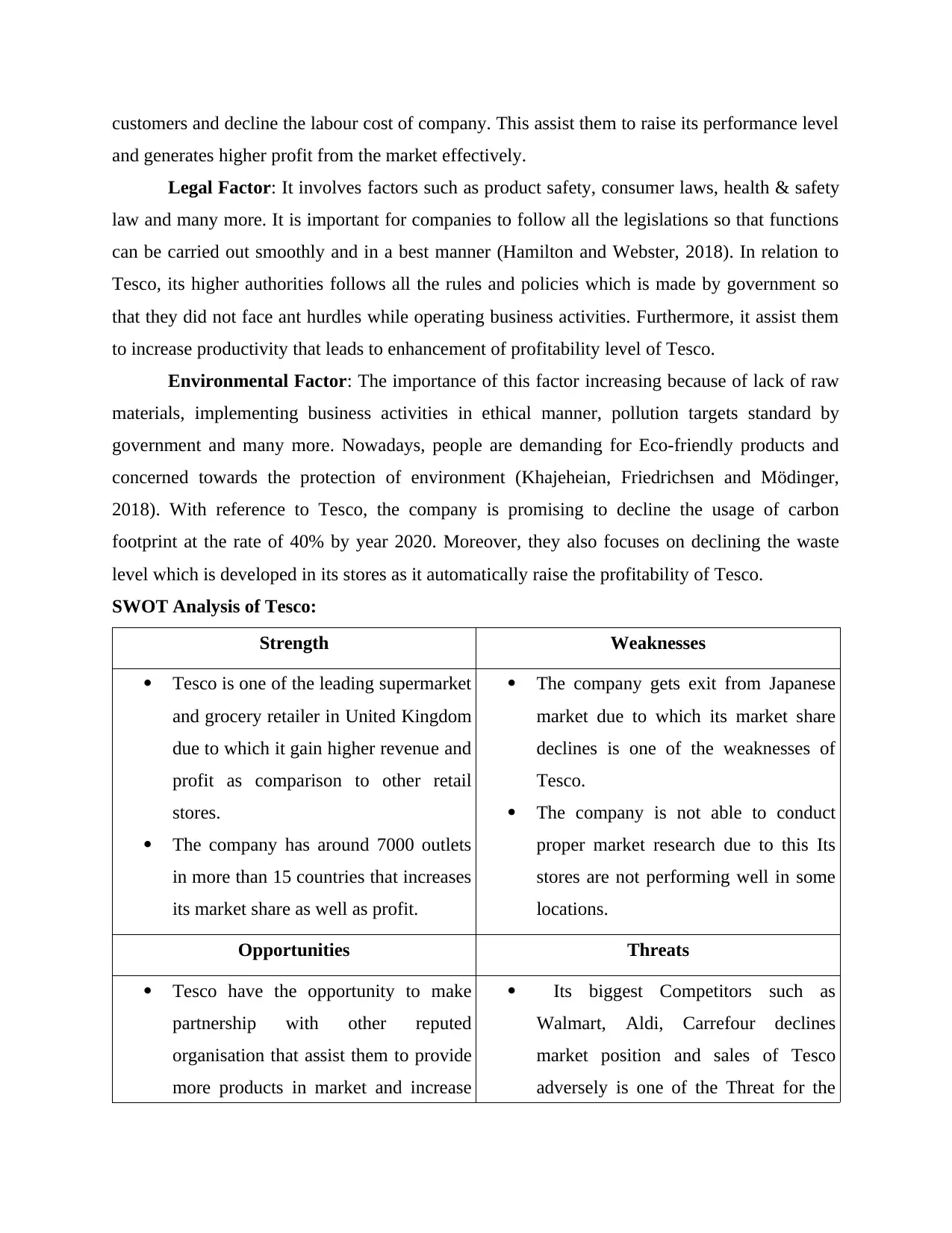
customers and decline the labour cost of company. This assist them to raise its performance level
and generates higher profit from the market effectively.
Legal Factor: It involves factors such as product safety, consumer laws, health & safety
law and many more. It is important for companies to follow all the legislations so that functions
can be carried out smoothly and in a best manner (Hamilton and Webster, 2018). In relation to
Tesco, its higher authorities follows all the rules and policies which is made by government so
that they did not face ant hurdles while operating business activities. Furthermore, it assist them
to increase productivity that leads to enhancement of profitability level of Tesco.
Environmental Factor: The importance of this factor increasing because of lack of raw
materials, implementing business activities in ethical manner, pollution targets standard by
government and many more. Nowadays, people are demanding for Eco-friendly products and
concerned towards the protection of environment (Khajeheian, Friedrichsen and Mödinger,
2018). With reference to Tesco, the company is promising to decline the usage of carbon
footprint at the rate of 40% by year 2020. Moreover, they also focuses on declining the waste
level which is developed in its stores as it automatically raise the profitability of Tesco.
SWOT Analysis of Tesco:
Strength Weaknesses
Tesco is one of the leading supermarket
and grocery retailer in United Kingdom
due to which it gain higher revenue and
profit as comparison to other retail
stores.
The company has around 7000 outlets
in more than 15 countries that increases
its market share as well as profit.
The company gets exit from Japanese
market due to which its market share
declines is one of the weaknesses of
Tesco.
The company is not able to conduct
proper market research due to this Its
stores are not performing well in some
locations.
Opportunities Threats
Tesco have the opportunity to make
partnership with other reputed
organisation that assist them to provide
more products in market and increase
Its biggest Competitors such as
Walmart, Aldi, Carrefour declines
market position and sales of Tesco
adversely is one of the Threat for the
and generates higher profit from the market effectively.
Legal Factor: It involves factors such as product safety, consumer laws, health & safety
law and many more. It is important for companies to follow all the legislations so that functions
can be carried out smoothly and in a best manner (Hamilton and Webster, 2018). In relation to
Tesco, its higher authorities follows all the rules and policies which is made by government so
that they did not face ant hurdles while operating business activities. Furthermore, it assist them
to increase productivity that leads to enhancement of profitability level of Tesco.
Environmental Factor: The importance of this factor increasing because of lack of raw
materials, implementing business activities in ethical manner, pollution targets standard by
government and many more. Nowadays, people are demanding for Eco-friendly products and
concerned towards the protection of environment (Khajeheian, Friedrichsen and Mödinger,
2018). With reference to Tesco, the company is promising to decline the usage of carbon
footprint at the rate of 40% by year 2020. Moreover, they also focuses on declining the waste
level which is developed in its stores as it automatically raise the profitability of Tesco.
SWOT Analysis of Tesco:
Strength Weaknesses
Tesco is one of the leading supermarket
and grocery retailer in United Kingdom
due to which it gain higher revenue and
profit as comparison to other retail
stores.
The company has around 7000 outlets
in more than 15 countries that increases
its market share as well as profit.
The company gets exit from Japanese
market due to which its market share
declines is one of the weaknesses of
Tesco.
The company is not able to conduct
proper market research due to this Its
stores are not performing well in some
locations.
Opportunities Threats
Tesco have the opportunity to make
partnership with other reputed
organisation that assist them to provide
more products in market and increase
Its biggest Competitors such as
Walmart, Aldi, Carrefour declines
market position and sales of Tesco
adversely is one of the Threat for the
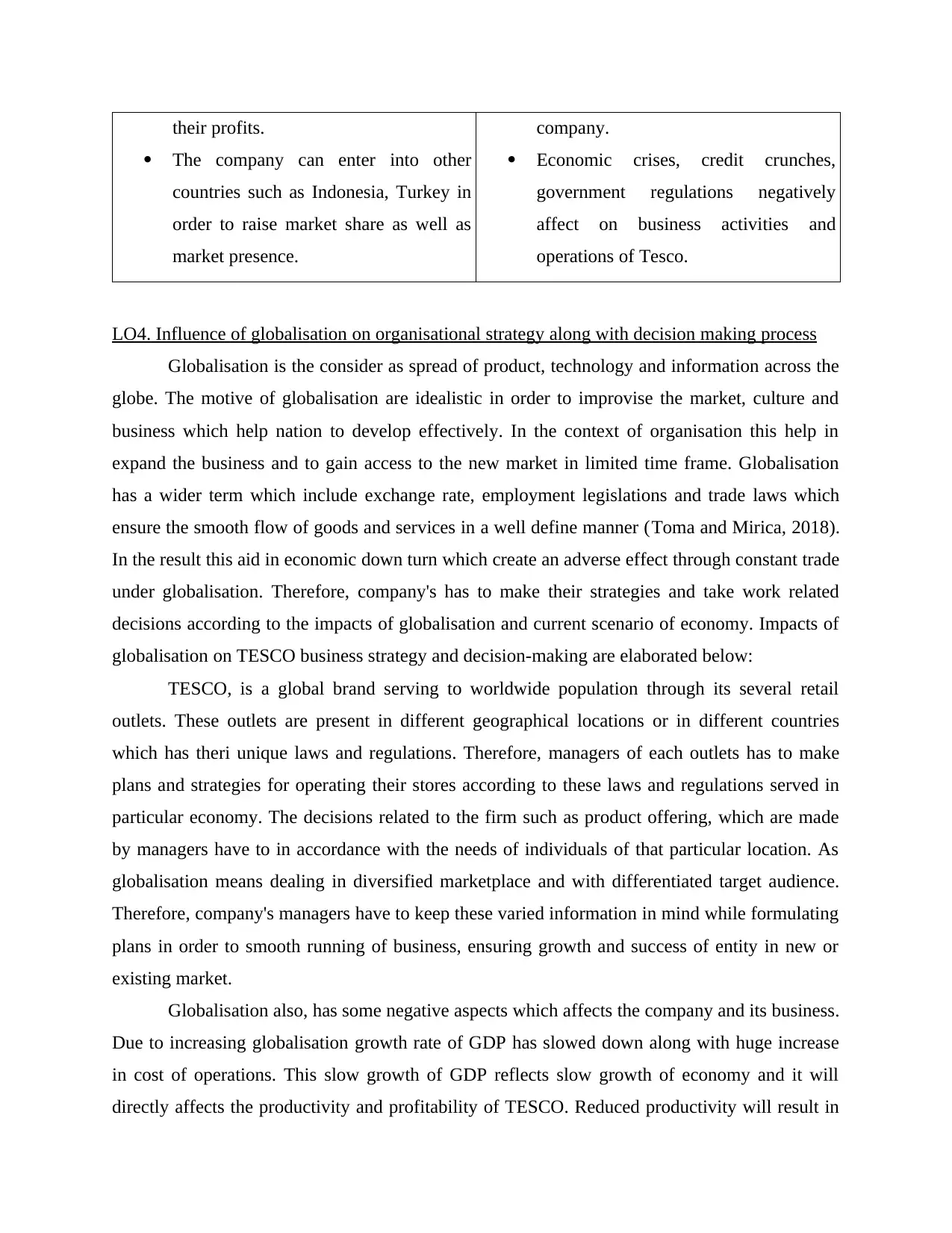
their profits.
The company can enter into other
countries such as Indonesia, Turkey in
order to raise market share as well as
market presence.
company.
Economic crises, credit crunches,
government regulations negatively
affect on business activities and
operations of Tesco.
LO4. Influence of globalisation on organisational strategy along with decision making process
Globalisation is the consider as spread of product, technology and information across the
globe. The motive of globalisation are idealistic in order to improvise the market, culture and
business which help nation to develop effectively. In the context of organisation this help in
expand the business and to gain access to the new market in limited time frame. Globalisation
has a wider term which include exchange rate, employment legislations and trade laws which
ensure the smooth flow of goods and services in a well define manner (Toma and Mirica, 2018).
In the result this aid in economic down turn which create an adverse effect through constant trade
under globalisation. Therefore, company's has to make their strategies and take work related
decisions according to the impacts of globalisation and current scenario of economy. Impacts of
globalisation on TESCO business strategy and decision-making are elaborated below:
TESCO, is a global brand serving to worldwide population through its several retail
outlets. These outlets are present in different geographical locations or in different countries
which has theri unique laws and regulations. Therefore, managers of each outlets has to make
plans and strategies for operating their stores according to these laws and regulations served in
particular economy. The decisions related to the firm such as product offering, which are made
by managers have to in accordance with the needs of individuals of that particular location. As
globalisation means dealing in diversified marketplace and with differentiated target audience.
Therefore, company's managers have to keep these varied information in mind while formulating
plans in order to smooth running of business, ensuring growth and success of entity in new or
existing market.
Globalisation also, has some negative aspects which affects the company and its business.
Due to increasing globalisation growth rate of GDP has slowed down along with huge increase
in cost of operations. This slow growth of GDP reflects slow growth of economy and it will
directly affects the productivity and profitability of TESCO. Reduced productivity will result in
The company can enter into other
countries such as Indonesia, Turkey in
order to raise market share as well as
market presence.
company.
Economic crises, credit crunches,
government regulations negatively
affect on business activities and
operations of Tesco.
LO4. Influence of globalisation on organisational strategy along with decision making process
Globalisation is the consider as spread of product, technology and information across the
globe. The motive of globalisation are idealistic in order to improvise the market, culture and
business which help nation to develop effectively. In the context of organisation this help in
expand the business and to gain access to the new market in limited time frame. Globalisation
has a wider term which include exchange rate, employment legislations and trade laws which
ensure the smooth flow of goods and services in a well define manner (Toma and Mirica, 2018).
In the result this aid in economic down turn which create an adverse effect through constant trade
under globalisation. Therefore, company's has to make their strategies and take work related
decisions according to the impacts of globalisation and current scenario of economy. Impacts of
globalisation on TESCO business strategy and decision-making are elaborated below:
TESCO, is a global brand serving to worldwide population through its several retail
outlets. These outlets are present in different geographical locations or in different countries
which has theri unique laws and regulations. Therefore, managers of each outlets has to make
plans and strategies for operating their stores according to these laws and regulations served in
particular economy. The decisions related to the firm such as product offering, which are made
by managers have to in accordance with the needs of individuals of that particular location. As
globalisation means dealing in diversified marketplace and with differentiated target audience.
Therefore, company's managers have to keep these varied information in mind while formulating
plans in order to smooth running of business, ensuring growth and success of entity in new or
existing market.
Globalisation also, has some negative aspects which affects the company and its business.
Due to increasing globalisation growth rate of GDP has slowed down along with huge increase
in cost of operations. This slow growth of GDP reflects slow growth of economy and it will
directly affects the productivity and profitability of TESCO. Reduced productivity will result in
⊘ This is a preview!⊘
Do you want full access?
Subscribe today to unlock all pages.

Trusted by 1+ million students worldwide
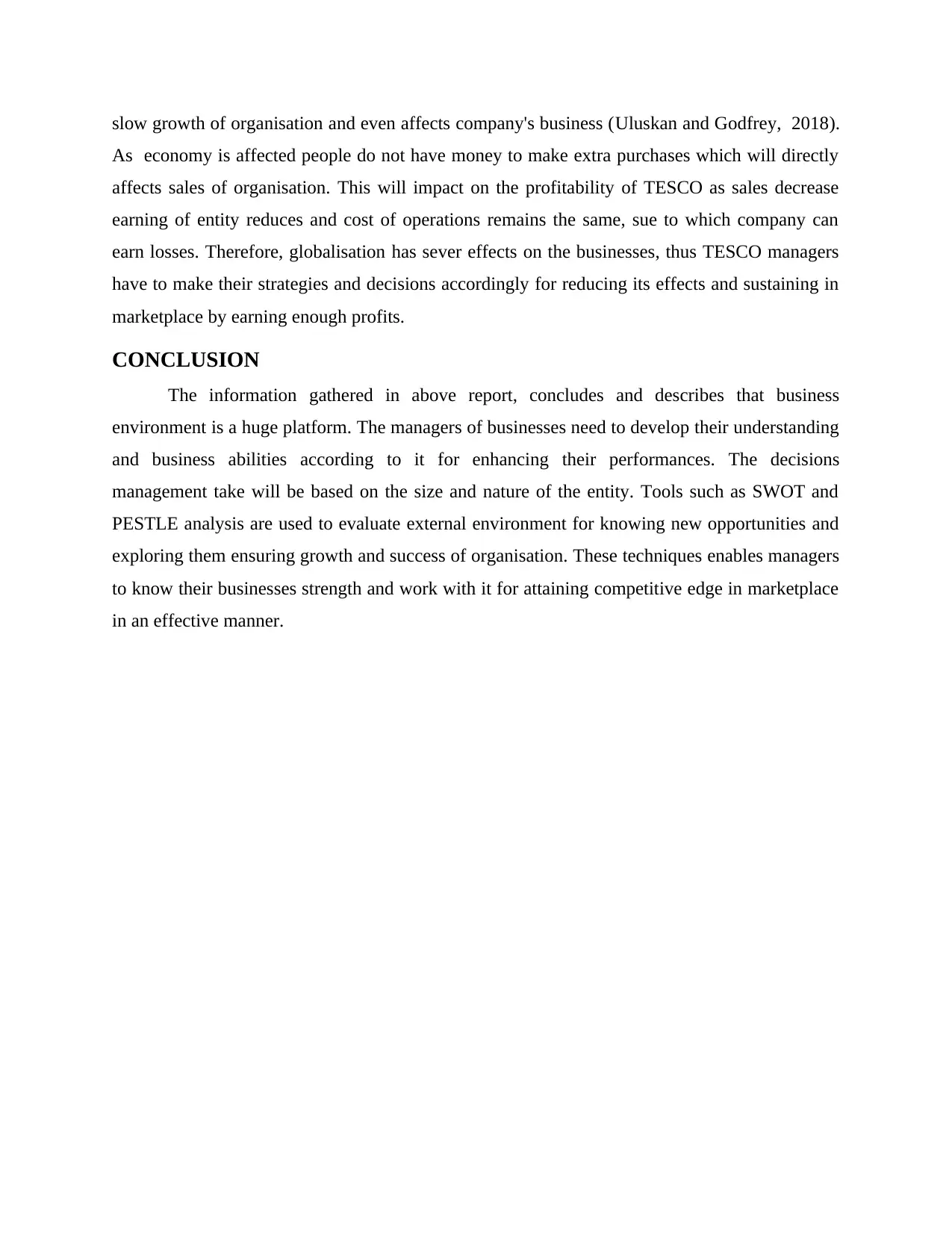
slow growth of organisation and even affects company's business (Uluskan and Godfrey, 2018).
As economy is affected people do not have money to make extra purchases which will directly
affects sales of organisation. This will impact on the profitability of TESCO as sales decrease
earning of entity reduces and cost of operations remains the same, sue to which company can
earn losses. Therefore, globalisation has sever effects on the businesses, thus TESCO managers
have to make their strategies and decisions accordingly for reducing its effects and sustaining in
marketplace by earning enough profits.
CONCLUSION
The information gathered in above report, concludes and describes that business
environment is a huge platform. The managers of businesses need to develop their understanding
and business abilities according to it for enhancing their performances. The decisions
management take will be based on the size and nature of the entity. Tools such as SWOT and
PESTLE analysis are used to evaluate external environment for knowing new opportunities and
exploring them ensuring growth and success of organisation. These techniques enables managers
to know their businesses strength and work with it for attaining competitive edge in marketplace
in an effective manner.
As economy is affected people do not have money to make extra purchases which will directly
affects sales of organisation. This will impact on the profitability of TESCO as sales decrease
earning of entity reduces and cost of operations remains the same, sue to which company can
earn losses. Therefore, globalisation has sever effects on the businesses, thus TESCO managers
have to make their strategies and decisions accordingly for reducing its effects and sustaining in
marketplace by earning enough profits.
CONCLUSION
The information gathered in above report, concludes and describes that business
environment is a huge platform. The managers of businesses need to develop their understanding
and business abilities according to it for enhancing their performances. The decisions
management take will be based on the size and nature of the entity. Tools such as SWOT and
PESTLE analysis are used to evaluate external environment for knowing new opportunities and
exploring them ensuring growth and success of organisation. These techniques enables managers
to know their businesses strength and work with it for attaining competitive edge in marketplace
in an effective manner.
Paraphrase This Document
Need a fresh take? Get an instant paraphrase of this document with our AI Paraphraser
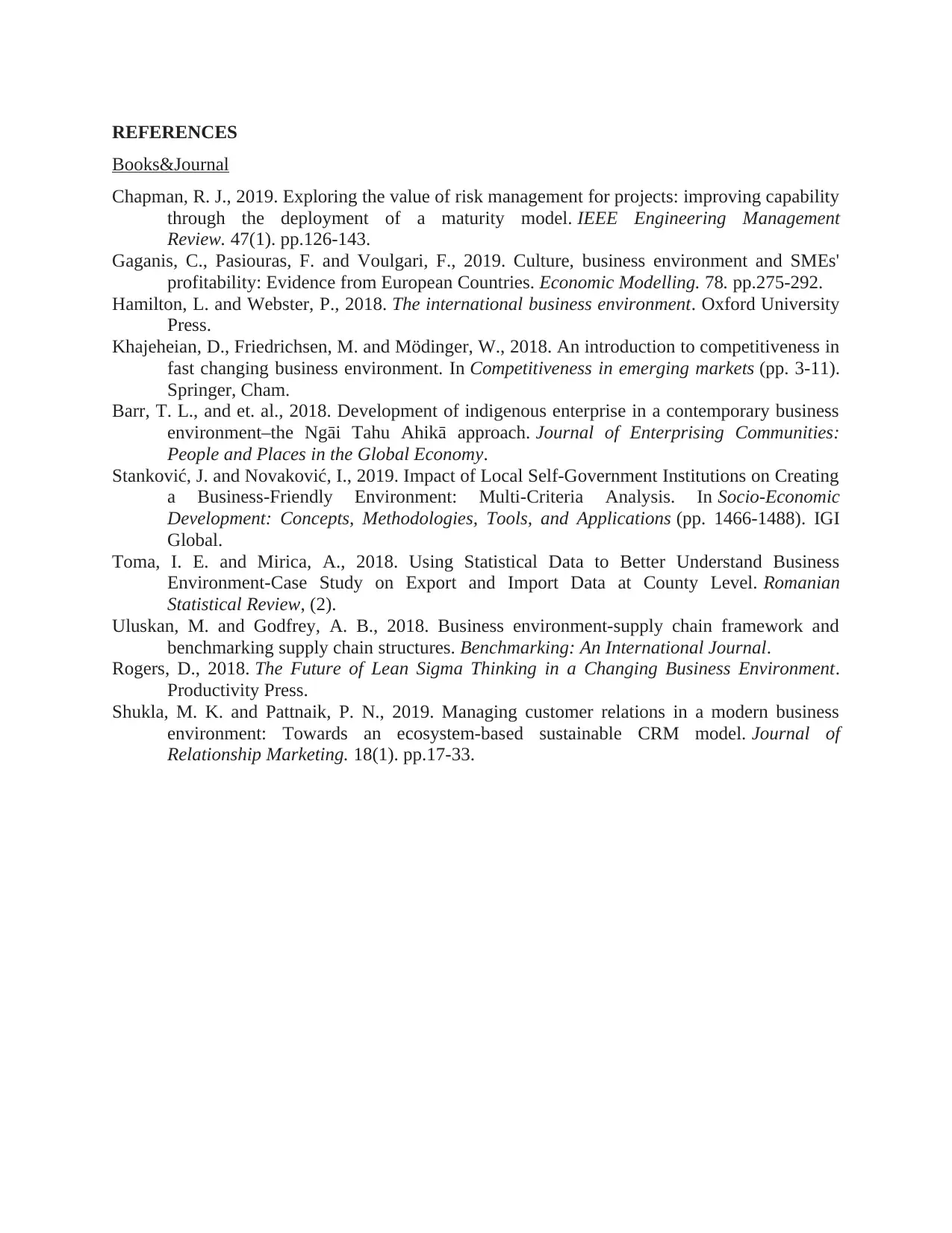
REFERENCES
Books&Journal
Chapman, R. J., 2019. Exploring the value of risk management for projects: improving capability
through the deployment of a maturity model. IEEE Engineering Management
Review. 47(1). pp.126-143.
Gaganis, C., Pasiouras, F. and Voulgari, F., 2019. Culture, business environment and SMEs'
profitability: Evidence from European Countries. Economic Modelling. 78. pp.275-292.
Hamilton, L. and Webster, P., 2018. The international business environment. Oxford University
Press.
Khajeheian, D., Friedrichsen, M. and Mödinger, W., 2018. An introduction to competitiveness in
fast changing business environment. In Competitiveness in emerging markets (pp. 3-11).
Springer, Cham.
Barr, T. L., and et. al., 2018. Development of indigenous enterprise in a contemporary business
environment–the Ngāi Tahu Ahikā approach. Journal of Enterprising Communities:
People and Places in the Global Economy.
Stanković, J. and Novaković, I., 2019. Impact of Local Self-Government Institutions on Creating
a Business-Friendly Environment: Multi-Criteria Analysis. In Socio-Economic
Development: Concepts, Methodologies, Tools, and Applications (pp. 1466-1488). IGI
Global.
Toma, I. E. and Mirica, A., 2018. Using Statistical Data to Better Understand Business
Environment-Case Study on Export and Import Data at County Level. Romanian
Statistical Review, (2).
Uluskan, M. and Godfrey, A. B., 2018. Business environment-supply chain framework and
benchmarking supply chain structures. Benchmarking: An International Journal.
Rogers, D., 2018. The Future of Lean Sigma Thinking in a Changing Business Environment.
Productivity Press.
Shukla, M. K. and Pattnaik, P. N., 2019. Managing customer relations in a modern business
environment: Towards an ecosystem-based sustainable CRM model. Journal of
Relationship Marketing. 18(1). pp.17-33.
Books&Journal
Chapman, R. J., 2019. Exploring the value of risk management for projects: improving capability
through the deployment of a maturity model. IEEE Engineering Management
Review. 47(1). pp.126-143.
Gaganis, C., Pasiouras, F. and Voulgari, F., 2019. Culture, business environment and SMEs'
profitability: Evidence from European Countries. Economic Modelling. 78. pp.275-292.
Hamilton, L. and Webster, P., 2018. The international business environment. Oxford University
Press.
Khajeheian, D., Friedrichsen, M. and Mödinger, W., 2018. An introduction to competitiveness in
fast changing business environment. In Competitiveness in emerging markets (pp. 3-11).
Springer, Cham.
Barr, T. L., and et. al., 2018. Development of indigenous enterprise in a contemporary business
environment–the Ngāi Tahu Ahikā approach. Journal of Enterprising Communities:
People and Places in the Global Economy.
Stanković, J. and Novaković, I., 2019. Impact of Local Self-Government Institutions on Creating
a Business-Friendly Environment: Multi-Criteria Analysis. In Socio-Economic
Development: Concepts, Methodologies, Tools, and Applications (pp. 1466-1488). IGI
Global.
Toma, I. E. and Mirica, A., 2018. Using Statistical Data to Better Understand Business
Environment-Case Study on Export and Import Data at County Level. Romanian
Statistical Review, (2).
Uluskan, M. and Godfrey, A. B., 2018. Business environment-supply chain framework and
benchmarking supply chain structures. Benchmarking: An International Journal.
Rogers, D., 2018. The Future of Lean Sigma Thinking in a Changing Business Environment.
Productivity Press.
Shukla, M. K. and Pattnaik, P. N., 2019. Managing customer relations in a modern business
environment: Towards an ecosystem-based sustainable CRM model. Journal of
Relationship Marketing. 18(1). pp.17-33.

1
⊘ This is a preview!⊘
Do you want full access?
Subscribe today to unlock all pages.

Trusted by 1+ million students worldwide
1 out of 12
Related Documents
Your All-in-One AI-Powered Toolkit for Academic Success.
+13062052269
info@desklib.com
Available 24*7 on WhatsApp / Email
![[object Object]](/_next/static/media/star-bottom.7253800d.svg)
Unlock your academic potential
Copyright © 2020–2025 A2Z Services. All Rights Reserved. Developed and managed by ZUCOL.



